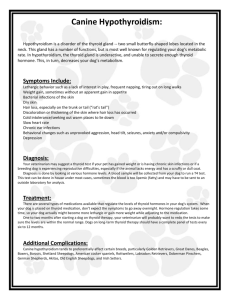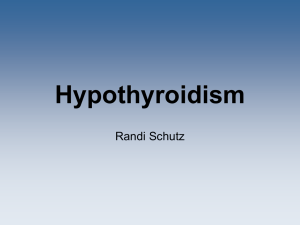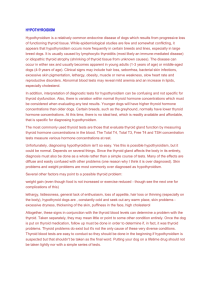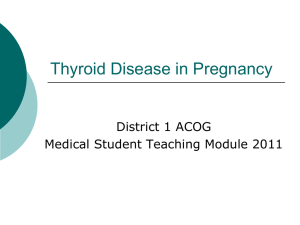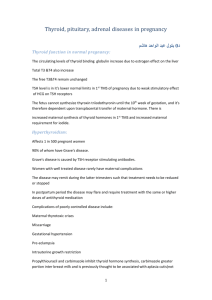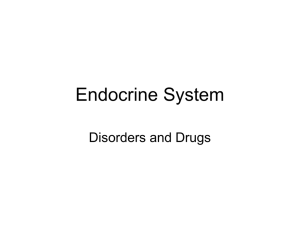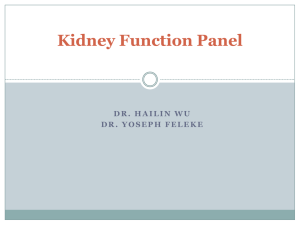HYPOTHYROIDISM DURING PREGNANCY Hypothyroidism During
advertisement
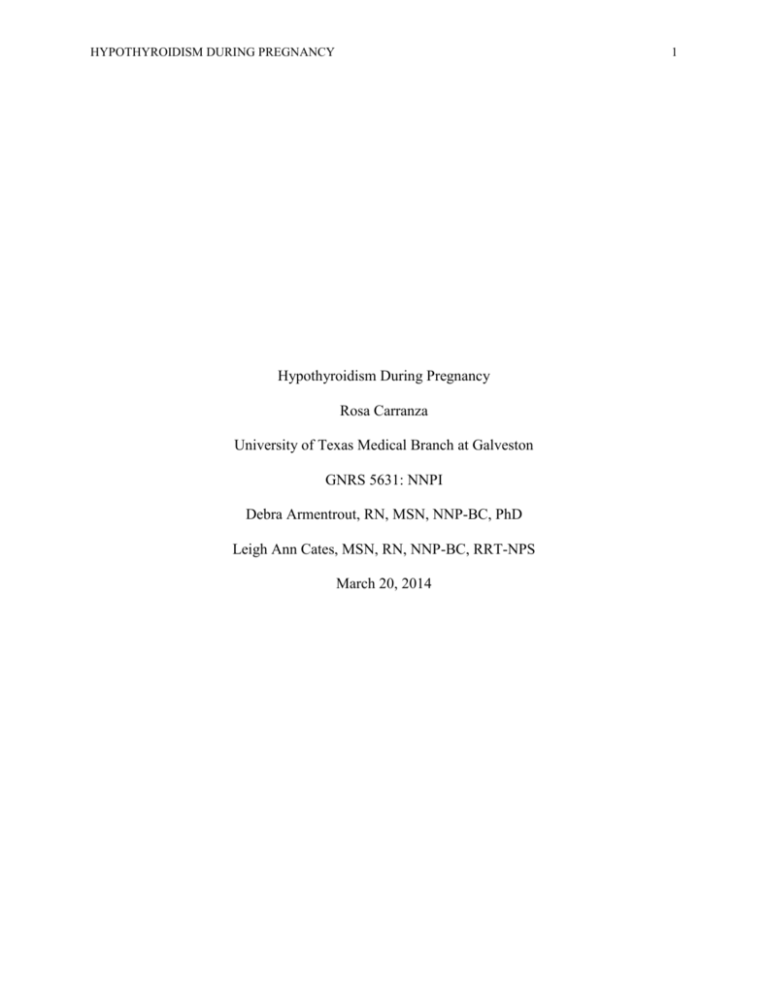
HYPOTHYROIDISM DURING PREGNANCY 1 Hypothyroidism During Pregnancy Rosa Carranza University of Texas Medical Branch at Galveston GNRS 5631: NNPI Debra Armentrout, RN, MSN, NNP-BC, PhD Leigh Ann Cates, MSN, RN, NNP-BC, RRT-NPS March 20, 2014 HYPOTHYROIDISM DURING PREGNANCY 2 Introduction Hypothyroidism during pregnancy can result from various causes, including autoimmune disorders, Hashimoto thyroiditis, and iodine deficiency. It can also be seen in women whose thyroids have been surgically removed or ablated with radioactive iodine for the treatment of Grave’s disease. During pregnancy there is an increased need for thyroid hormone production in order to support the changes in metabolism required to provide adequate nutrients for fetal growth, and to meet the increased physiologic demands facing the mother. Hypothyroidism in pregnancy can have severe consequences, since thyroid hormones are essential for regulating metabolic processes in every body system and in the developing fetus. Untreated hypothyroidism can adversely affect both mother and fetus by increasing the risk of fetal loss, preterm birth, preeclampsia, and cesarean delivery (Blackburn, 2013). The damaging effects of hypothyroidism can further extend into the newborn period by negatively impacting neurologic growth and development in the infant. Pathophysiology The thyroid gland produces triiodothyronine (T3) and thyroxine (T4). Thyroid cells also function to transport, store, and oxidize iodine. Oxidized iodine is bound to tyrosine, forming monoiodotyrosines and diiodotyrosines, the components of T3 and T4. The thyroid secretes T3 and T4 under the regulation of the hypothalamic-pituitary-thyroid axis (HPT). The hypothalamus releases thyrotropin-releasing hormone (TRH) in response to low circulating T3 and T4 levels. TRH stimulates the anterior pituitary to produce thyroid-stimulating hormone (TSH). TSH then acts on the thyroid gland to increase thyroid hormone production. Through negative feedback, thyroid hormones control the release of TRH from the hypothalamus and TSH from the anterior pituitary (Blackburn, 2013). HYPOTHYROIDISM DURING PREGNANCY 3 In plasma, nearly all thyroid hormones are bound to the proteins thyroxine-binding globulin (TBG), transthyretin, or albumin. Of these proteins, TBG is the major carrier (Blackburn, 2013). Thyroid hormone receptors in cells have a greater affinity for T3. Eighty percent of T3 in the tissues is produced by deiodination of T4 to T3. The iodine released in the process, is then re-concentrated by the thyroid or eliminated by the kidneys. Pregnancy hormones alter thyroid function in various ways. First, increased estrogen leads to a 2-3 fold elevation in thyroid binding globulin (TBG). The increased binding ability of TBG results in decreased levels of free thyroid hormones; which in turn stimulates a rise in serum TSH. Second, elevation of human chorionic gonadotropin (hCG) results in increased production of T3 and T4. This happens because hCG resembles TSH in structure. The resultant rise in T3 and T4 decreases TSH from the anterior pituitary. However, the rise in T3 and T4 is less than the rise in TBG, decreasing the ratio of T4 to TBG; resulting in a relative hypothyroxinemia. Finally, in the 2nd and 3rd trimesters, the placenta increases production of type II and III monodeiodinase enzymes, which catabolize thyroid hormones (Blackburn, 2013). Without adequate maternal thyroid function and regulation, these changes can result in hypothryroidism during pregnancy. Iodine metabolism and clearance are also altered during pregnancy. There is an increased iodine need, and the thyroid gland increases uptake of iodine. However, the maternal pool of iodine is altered due to increased renal clearance of iodine. The increased renal losses of iodine are due to the increased renal blood flow and glomerular filtration rate associated with pregnancy. Additionally, iodine from the maternal pool is reduced when iodine is transferred across the placenta to the fetus. Iodine losses can result in hyperplasia of the maternal thyroid gland, with mild hyperplasia (between 10%-15%), seen in areas that have adequate iodine in the diet. HYPOTHYROIDISM DURING PREGNANCY 4 Women who live in areas with inadequate iodine consumption demonstrate an increased thyroid volume between 15%-30%, and are at significant risk for goiter as well as decreased thyroid hormone production (Blackburn, 2013). Impact on the fetus Maternal hypothyroidism is associated with impaired neurodevelopment of the fetus. In the 1st 10-12 weeks, during the period of rapid fetal brain development, the fetus is completely dependent on maternal (T4). Maternal thyroid hormones are critical for brain development, neurogenesis, neuron migration, axon and dendrite formation, and organization. They play a role in fetal lung maturation and surfactant production; calcium and vitamin D homeostasis for bone growth; and in thermogenesis (Blackburn, 2013). Thyroid hormones are also responsible for the prenatal and postnatal maturation of the retina and cochlea (Rose, 2009). For these reasons, adequate supplies of maternal T4 are especially important in the 1st trimester when the fetal thyroid is not functioning optimally. In the 2nd and 3rd trimesters, maternal T4 continues to supply the fetus, promoting continued neurologic development and neuroprotection. Due to early birth, infants born prematurely lose this valuable supply of maternal T4. Hypothyroidism in the fetus may result due to maternal iodine deficiency or due to low maternal thyroid hormone levels. It can also result from abnormal development and/or function of the fetal thyroid gland; or abnormal development and/or function of the fetal pituitary gland (National Library of Medicine, 2014). The fetal thyroid gland develops in the 1st 12 weeks of gestation. By 6-8 weeks the hypothalamus begins to produce thyrotropin-releasing hormone. TSH can be detected by 10-12 weeks. The fetal thyroid begins to accumulate and concentrate iodine by 10-12 weeks. Fetal T4 can be detected by 12 weeks. T3 levels remain low until after 30 weeks because the fetus cannot convert T4 to T3 peripherally due to immature enzyme HYPOTHYROIDISM DURING PREGNANCY 5 systems. Even with the capacity to secrete TSH and TRH in early gestation, fetal thyroid function remains at basal level until mid-gestation, when the hypothalamic-pituitary thyroid axis matures along with increasing gestation (Blackburn, 2013). Therapeutic approaches and treatment options Hypothyroidism may be difficult to diagnose in pregnant women. Some symptoms of hypothyroidism, like fatigue, constipation, and weight gain mimic the typical physiologic changes that most women experience during pregnancy. This overlap of symptoms can make diagnosing challenging for providers (Ross, 2014). In 2012 The Endocrine Society issued clinical practice guidelines for the management of thyroid dysfunction during pregnancy and post partum. Due to the changes in thyroid function that occur during pregnancy, they recommend caution in interpreting maternal serum free T4 levels. They also advise the use of trimester specific reference ranges. In women diagnosed with hypothyroidism before pregnancy, they recommend adjusting the preconception Levothyroxine dose to produce a TSH level no higher than 2.5 mlU/L. They further urge a Levothyroxine dose increase of 30%, or more, by 4-6 weeks of pregnancy. If hypothyroidism is diagnosed during pregnancy, thyroid function should be normalized as soon as possible by initiating Levothyroxine therapy and titrating the dosage to maintain a TSH of less than 2.5 mlU/L in the 1st trimester. With initiation of Levothyroxine therapy, thyroid function tests should be evaluated within 30 days, then every 4-6 weeks. Additionally, since iodine is necessary for appropriate production of thyroid hormones, they recommend women of childbearing age have an average iodine intake of 150 mcg/day. Pregnant or breastfeeding women are advised to increase their intake to 250 mcg/day. With regard to screening, at this time, evidence does not warrant the universal screening of all pregnant women for HYPOTHYROIDISM DURING PREGNANCY 6 hypothyroidism. Instead, it is recommended that high-risk women be identified based on their medical history and exam (De Groot, Abalovich, Alexander, Amino, Barbour, Cobin, Eastman, Lazarus, Luton, Mandel, Mestman, Rovert, & Sullivan, 2012). Clinical manifestations and diagnosis of the neonate Congenital hypothyroidism (CH) is defined as thyroid function that is significantly decreased or absent at birth. It occurs in 1 in 3000 – 4000 live births, with 15% of cases being hereditary and 85% occurring sporadically. CH has a higher incidence in Hispanics and lower incidence in African Americans. Additionally, it happens twice as frequently in female infants than in male infants (Palla & Srinivasan, 2013). If CH results from abnormal thyroid gland development or altered thyroid hormone production, it is referred to as primary hypothyroidism. If it results from decreased TSH production or function, it is classified as secondary hypothyroidism. Additionally CH can be permanent, requiring lifelong replacement of thyroid hormone, or transient with eventual recovery of normal thyroid hormone production (Rastogi & LaFranchi, 2010). Initially, in some infants, clinical manifestations may be subtle or missing at birth. This is probably due to the passage of some maternal T4 up until the placenta is separated. Symptoms can be mild or severe depending on thyroid hormone level at the time. Symptoms can include mental retardation, deafness, poor feeding, constipation, jaundice, hypotonia, and hoarse cry. On physical exam, affected infants may exhibit widely separated sutures, large fontanelles, facial edema, low hairline, short arms and legs, wide hands with short fingers, cold/mottled skin, umbilical hernia, and macroglossia (National Library of Medicine, 2014). Furthermore, infants with CH have an increased risk of having additional associated congenital malformations. Associated malformations can include cardiac anomalies, cleft palate, neurologic abnormalities, HYPOTHYROIDISM DURING PREGNANCY 7 and genitourinary malformations. Infants with Down’s syndrome have also demonstrated an increased incidence of CH (Rastogi & LaFranchi, 2010). Untreated congenital hypothyroidism can result in severely stunted growth and mental retardation, also known as cretinism (Rose, 2011). The degree of mental retardation is related to the severity and duration of the hypothyroidism that the fetus or infant was exposed to. The brain is most susceptible to hypothyroidism during the fetal and neonatal periods when there is rapid growth and development. According to Rose (2011), inadequate growth and permanent brain damage do not occur if hypothyroidism develops after brain maturation is complete (after postnatal age 2-3 years). Even mild hypothyroidism, if untreated, can result in severe neurologic impairment and poor growth. Consequently, early diagnosis and treatment of congenital hypothyroidism are associated with improved neurologic outcomes. In December of 2011, the American Academy of Pediatrics (AAP) along with the American Thyroid Association, and the Lawson Wilkins Pediatric Endocrine Society, reaffirmed their 2006 screening and treatment recommendations for congenital hypothyroidism. They endorse routine mass screening of all newborns in order to identify those afflicted with hypothyroidism. They state that infants with low T4 and TSH greater than 40 mU/L are considered to have primary hypothyroidism. In order to achieve the best possible neurologic outcomes, adequate treatment must be initiated in a timely manner. If thyroid hormone replacement therapy is started within two weeks of age, cognitive development can be normalized (American Academy of Pediatrics, American Thyroid Association, & Lawson Wilkins Pediatric Endocrine Society, 2011). For the infant with an abnormal newborn screen result, serum T4 and TSH testing must be conducted in order to confirm the diagnosis. After the confirmatory T4 and TSH are drawn, HYPOTHYROIDISM DURING PREGNANCY replacement therapy with Levothyroxine 10-15 mcg/kg should be started. In order to avoid delays in treatment, Levothyroxine therapy should be started without waiting for the confirmatory lab results. A complete history should be obtained, including maternal prenatal thyroid status, as well as family history of thyroid disease. A thorough physical exam should be conducted to assess for any signs or symptoms of hypothyroidism. Referral to a pediatric endocrinologist should be made for optimal management. Parents must be educated on the causes of CH, importance of early diagnosis to prevent mental retardation, appropriate administration of Levothyroxine, the importance of medication compliance, and the importance of follow up medical exams. Functioning thyroid tissue can be identified using diagnostic ultrasonography and/or thyroid uptake scans with the radioisotopes iodine 123 or sodium technetium 99m. Controversy over the risks of using radiation scans on infants exists. For this reason, many clinicians prefer ultrasonography for initial investigation (AAP et al., 2011). The goal of thyroid hormone replacement therapy in infants is to normalize TSH and maintain T4 in the upper end of the age appropriate reference range. Frequent laboratory and clinical evaluations of thyroid function will be needed. Palla & Srinivasan (2013) recommend T4 and TSH monitoring as follows: at 2 and 4 weeks after staring therapy every 1-2 months in the 1st 6 months of life every 3-4 months between 6 months and 3 years every 6-12 months until growth is completed more frequently with dose changes, abnormal results, or with compliance concerns Pertinent theories and evidence based practice 8 HYPOTHYROIDISM DURING PREGNANCY 9 In the newborn period, newborn screening programs are recommended by the AAP in order to detect those infants afflicted with hypothyroidism. In the United States, and many other developed countries, there is routine screening of all newborns. Blood from a capillary heel prick is collected on filter paper. Ideally, this is done between 2-4 days of age, before hospital discharge. However, samples cannot always be collected during the recommended time frame in situations involving hospital discharge before 48 hours, home birth, or with critically ill neonates. In critically ill or preterm infants, blood should be collected by 7 days of age. Samples collected in the first 24 – 48 hours of life may result in falsely positive TSH elevations. In some states, a second specimen is collected between 2 and 6 weeks of age. States that collect the second sample report that approximately 10% of the afflicted infants they diagnose with congenital hypothyroidism are found due to the second screening. Newborn screening programs detect CH with different strategies. Some screen for a primary TSH with a backup T4, some use primary T4 with backup TSH, and some use a combined primary TSH plus T4. In the United States, most programs use a primary TSH screening with evaluation of T4 in infants found to have an elevated TSH level (AAP et al., 2011). In order to avoid misdiagnosing some infants, Smith (2007) states that primary care providers must be aware of the limitations encountered with current screening methods. Primary TSH screening with backup T4, which is the method used by most programs in the United States, misses delayed TSH elevation in infants with thyroxine-binding globulin (TBG) deficiency, central hypothyroidism, or hypothyroxinemia. Screening of primary T4 with backup TSH detects primary hypothyroidism, TBG deficiency, central hypothyroidism, and HYPOTHYROIDISM DURING PREGNANCY 10 hyperthyroxinemia; however, it misses hyperthyroxinemia in infants with delayed TSH elevation and an initially normal T4. In their reaffirmation of newborn screening and therapy for congenital hypothyroidism, the AAP et al. (2011) encourage providers to trust their clinical judgment and experience when they encounter an infant with normal screening results, but who exhibit symptoms of hypothyroidism. There should be high suspicion in infants who fail to develop normally, since it is possible for hypothyroidism to be acquired after the period of newborn screening. AAP et al. (2011) further point out that errors during the initial newborn screening process are possible, and can contribute to missing the diagnosis. Additionally, human error resulting in failure to communicate abnormal results is also a possibility. For these reasons, clinicians are encouraged to evaluate serum free T4 and TSH when clinical signs and symptoms raise suspicion of hypothyroidism; regardless of the initial newborn screening results. Economic, emotional, and social implications on the family Parents of infants affected by hypothyroidism may experience anxiety and psychological distress. They may have difficulty understanding the disease and its consequences, and may feel overwhelmed with the associated therapy, follow-up, and frequent screenings. If their infant suffers permanent mental retardation, they will be faced with the daunting task of providing life long care to their disabled child. Having a child with an illness or disability can produce many stressors for a family. It often brings financial burdens, time demands, and physical demands. Caring for a disabled child can affect a parent’s work due to the frequent medical appointments and the difficulty in finding adequate child-care. The combination of missed work and associated medical costs forces many families to rely on public support. Additionally, the time demands placed on these parents leave HYPOTHYROIDISM DURING PREGNANCY 11 little or no time for them to participate in social activities. The effort and time required to care for their sick or disabled child may limit or alter their interactions with their other children, and may even affect their decision to have more children. All of these factors can be associated with poor mental health outcomes for parents and siblings, and can negatively impact the health and well being of the sick child (Reichman, Cormanb, Noonan, 2008). With the universal screening of newborns and the widely available use of Levothyroxine for treatment, every effort must be made to improve the neurologic outcome of affected infants. This in turn will prevent permanent disability in the child, reduce mental and emotional distress for the family, decrease the time demands placed on them, and reduce their financial burden. Conclusion Hypothyroidism during pregnancy can have adverse consequences; the most serious being failure of appropriate neurologic development in the fetus. Mental retardation resulting from hypothyroidism is preventable with improved vigilance and treatment of high-risk women and their infants. In infants born with congenital hypothyroidism, the best outcomes are achieved when thyroid hormone replacement is initiated within the first two weeks of age. Today’s modern screening techniques and aggressive treatment regimens, in both pregnancy and in the newborn period, aim for early detection and correction of sub optimal thyroid hormone levels in order to minimize complications and optimize the infant’s neurologic outcomes. HYPOTHYROIDISM DURING PREGNANCY 12 References American Academy of Pediatrics, American Thyroid Association, & Lawson Wilkins Pediatric Endocrine Society (2011). Clinical report: Update of newborn screening and therapy for congenital hypothyroidism. Pediatrics, 117(6), 2290-2303. Retrieved from http://pediatrics.aappublications.org/content/129/4/e1103.full Blackburn, S. T. (Ed.). (2013). Maternal, fetal, & neonatal physiology; A clinical perspectivce (4th ed). Maryland Heights, MO: Elsevier Saunders. De Groot, L., M. Abalovich, E. K., Alexander, N., Amino, L., Barbour, R., Cobin, C., Eastman,, J., Lazarus, D., Luton, S., Mandel, J., Mestman, J., Rovert, & S., Sullivan, (2012). Management of thyroid dysfunction during pregnancy and postpartum: An Endocrine Society clinical practice guideline. The Journal of Clinical Endocrinology & Metabolism, 97, 2543-2565. Retrieved from https://www.endocrine.org/search?q=hypothyroidism%20pregnancy%20guidelines National Library of Medicine. (2014). Neonatal hypothyroidism. Retrieved from http://www.nlm.nih.gov/medlineplus/ency/article/001193.htm Palla, M.M. & Srinivasan, G. (2013). Thyroid disorders. In T.L. Gomella, M. D. Cunningham, & F. G. Eyal (Eds.), Neonatology; Management, procedures, on-call problems, diseases, and drugs (7th ed., 908-913). New York, NY: McGraw Hill. Rastogi, M. V. & LaFranchi S. (2010). Congenital hypothyroidism. Orphanet Journal of Rare Diseases, 5(17), doi:10.1186/1750-1172-5-17 Reichman, N. E., Corman, H., & Noonan, K. (2008). Impact of child disability on the family. Maternal and Child Health Journal, 12(6), 679-683. doi:10.1007/s10995-007-0307-z HYPOTHYROIDISM DURING PREGNANCY 13 Rose, S. R. (2011). Thyroid disorders. In R.J. Martin, A. A. Fanaroff, & M. C. Walsh (Eds.), Neonatal-perinatal medicine: Diseases of the fetus and infant (9th ed., 84483-85930). Saint Louis, MO: Elseviere. Ross, D. S. (2014). Hypothyroidism during pregnancy: Clinical manifestations, diagnosis, and treatment. In D.S. Cooper & C. J. Lockwood (Section Eds.) & J. E. Mulder (Deputy Ed.), UpToDate. Retrieved from http://www.uptodate.com/contents/hypothyroidism-duringpregnancy-clinical-manifestations-diagnosis-and-treatment Smith, L. (2007). Practice guidelines: Updated AAP guidelines on newborn screening and therapy for congenital hypothyroidism. American Family Physician, 76(3), 439-444. Retrieved from http://www.aafp.org/afp/2007/0801/p439.html


